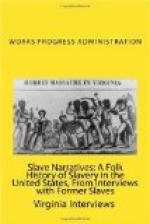I gets from $3 to $8 last month from the Sociable Welfare. My children helps me mighty little. They got their own children to see after and don’t make much.
Colonel Williams and Ed are both dead. They did give me a lot of fine clothes when I went to see them as long as they lived. I don’t know where the girls hab gone. Scattered around. I oughter never left my good old home and white folks. They was show always mighty good to me.
I never could sing much. I used to give the Rebbel Yell. Colonel Yopp give me a dime every time I give it. Since he died I ain’t yelled it no more. I learned it from Colonel Williams. I jess took it up hearing him about the place.
Folklore subjects
Name of Interviewer: Irene Robertson
Subject: Ex-Slave-Hunting
Story:—Information
This information given by: Henry Walker
Place of Residence: Hazen, Arkansas
Occupation: Farmer.
Age: 78
[TR: Information moved from bottom of first page.]
Henry Walker was born nine miles south of Nashville, Tennessee. Remembered the soldiers and ran to the windows to see them pass. One day he saw a lot of soldiers coming to the house. Henry ran in ahead and said out loud, “them Yankeys are coming up here.” The mistress slapped Henry, hid him and slammed the doors. The soldiers did not get in but they did other damage that day. They took all the mules out of the lot and drove them away. They filled their “dugout wagons” with corn. A dugout wagon would hold nearly a crib full of corn. They were high in front and back and came down to a point, nearly touched the ground between the wheels. The wheels had pens instead of axles in them.
The children ran like pigs every morning. The pigs ran to eat acorns and the children—white and black—to pick up chestnuts, scaly barks and hickory nuts. There were lots of black walnuts. “We had barrels of nuts to eat all winter and the mistress sold some every year at Nashville, Tennessee. The woods were full of nut trees and we had a few maple and sweet gum trees. We simmered down maple sap for brown sugar and chewed the sweet gum. We picked up chips to simmer the sweet maple sap down. We used elder tree wood to make faucets for syrup barrels. There were chenquipins down in the swamps that the children gathered.”
Henry Walker said that they were sent upon the hills to find ginsing and often found long beds of it. They put it in sacks and a man came and bought it from the mistress. The mistress’ name was Mrs. Williams. She kept the money for the ginsing and nuts too when she sold them.
Henry said he ate at Mrs. Williams’, but the other children ate at the cabin. On Saturday evening the horn would sound and every slave would come to get his allowance of provisions. They used a big bell hung up in a tree to call them to meals and to begin work. They could also hear other farm bells and horns. Colored folks could have dances if they would get permission. Some masters were overseers themselves and some hired overseers. Patty Rell was a white man and the bush-wackers give us trouble sometimes.




